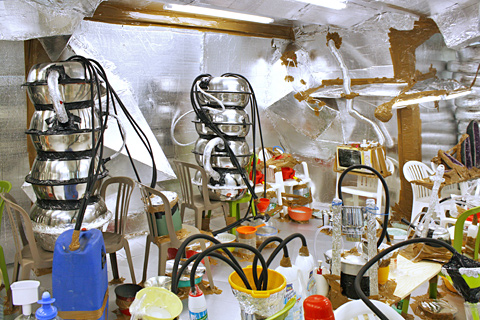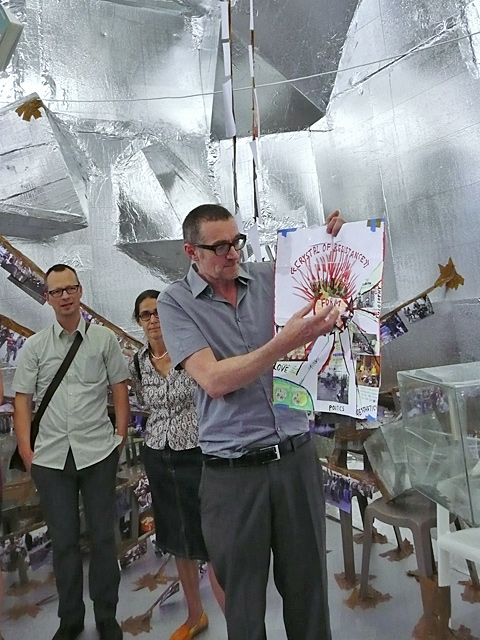Swiss identity cards, "ID" in short, contain various forgery-proof features, one of them being a hologram of a crystal. The shimmering mountain crystal belongs to the nation's iconography. Vacation chalets, hotels and even yogurts are named "Cristallina", while crystals are popular souvenirs and gigantic specimens are proudly showcased in exhibitions at many a Museum of Natural History. Switzerland's concentration of jewelers is also worthy of mention here.
The fact that Thomas Hirschhorn is presenting a "Crystal of Resistance" as Switzerland's contribution to this year's Venice Art Biennial gives plenty of reason to be curious, particularly because of the ordinarily political nature of his work. One of his first pieces was the large-format installation "Wirtschaftslandschaft Davos" (2001, Aargauer Kunsthaus Collection), which portrays Hirschhorn's birthplace as anything but a harmless Magic Mountain spa resort or exile for Expressionists. Exhibited during the high mass of globalization that we call the World Economic Forum, Davos looks like a well-equipped, neoliberal point of mobilization. As early as 2001, modeler Hirschhorn was using exaggeration as a stylistic device, meaning that the high mountain valley turned into a warzone.
Hirschhorn, a Swiss political artist
It is also worth remembering his "Swiss-Swiss-Democracy" exhibition at the Centre Culturel Suisse in Paris in 2004/2005, which proved a traumatic blow to Switzerland's spoiled, in a political sense rather lethargic art scene. But it was in fact Thomas Hirschhorn who managed to deflect a hefty budget cut for Pro Helvetia, the Swiss, state-subsidized culture foundation, which runs the center. For certain politicians had never before in their entire lives heard of a staged breach of taboo being used as a stylistic device in Modern art.
So what happened? At a theater production performed as part of Hirschhorn's exhibition, an actor played a dog that would lift its leg and piss on a portrait of the then Swiss Federal Councilor, Christoph Blocher, from Switzerland's right-wing, populist People's Party. Just for good measure, the play by Gwenael Morin was entitled "Wilhelm Tell". Nevertheless, for anyone who had been to the theater at least once in the last 40 years, it was easily recognizable as a piece of spoof director's theater. The butt of the joke, in the crude humor of Hirschhorn's allies, was the politically precarious exploitation of so-called national myths, a practice in which Christopher Blocher and his faithful followers are well-versed.
The exhibition underpinned Thomas Hirschhorn's growing reputation as a political artist in other ways too. Throwing in all of his usual ingredients – lots of brown tape, pamphlets, hand-written pieces, documents, newspapers, books, this time supplemented by a model railway as well as elements of performance in the form of a series of lectures – he openly questioned Switzerland's democratic constitution. The exhibition took place at a time in Switzerland when the Swiss People's Party, led by Christoph Blocher, employed xenophobic rabble-rousing as the central theme of their campaigns. In contrast, Hirschhorn asked the question: To what extent does a democracy also provide a haven for manipulative powers? These are uncomfortable questions for any country, let alone for a country that likes to depict itself as the cradle of direct democracy.
With such a background, one has no choice but to interpret Hirschhorn's "Crystal of Resistance" as piece of political art, representing his reply to the Biennial invitation extended to him by the Swiss Art Commission and his reply to the scandal made of his work in politics and the media. The invitation comes across as an attempt at reconciliation, one however that has come a little too late. It should be added that just in time to coincide with the Biennial, the Swiss Post released a special edition stamp designed by Hirschhorn – "Art is Resistance". Not a single politician made a peep. Now, if that is not a little suspect...
The crystal turned inwards
Now to place Hirschhorn's crystal and resistance under the lens. The first observation would be that the crystal is not a picture-perfect specimen with juts that point outwards with their sharp edges, gleaming. Rather, it is a giant geode big enough for people to walk inside. Thomas Hirschhorn made hardly any changes to the exterior of the Swiss pavilion designed by Bruno Giacometti, but he changed the interior beyond recognition. This gesture should be taken seriously; the artist created his own kingdom, establishing a world within. What is then taken from it into the outside world is down to the visitor. In addition, only those who venture into Hirschhorn's labyrinth risk cutting themselves – either on the glass splinters that adorn the walls and are intended to ward off foes, or, in a figurative sense, on the photography of gruesomely mutilated bodies from today's battlefields.
With the crystals only gleaming inwards, Thomas Hirschhorn rejects the nationalist interpretation of the crystal motif. He even avoids any association with the "Swissness" that is today so readily employed by marketing professionals. "When you steps through the doors, you really immerse yourself in my work, and that is my answer to all of the potential nationalist questions," comments Hirschhorn. Then he points out that there are crystals all over the world – even if he considers the local reference more fitting. After all, the "Crystal of Resistance" traces back to his encounter with a group of children 15 years ago in a car park at the Rhône Glacier, where they were selling small crystals on cardboard boxes.
An ambivalent relationship to folklore
Hirschhorn has an ambivalent relationship to folklore, as can been seen on the interior of his grotto of resistance. Boasting a stuffed groundhog and eagle, the grotto within a grotto is particularly striking – a thoroughly touristic display that one could easily stumble across in a middle-of-the-road hotel lobby. Indeed, the groundhog – practically a national symbol for Swiss resistance against adverse living conditions (in the case of danger, jump into the hole) – is placed next to a fan of news magazines. "Bringing the war home", the famous article by Martha Rosler, springs to mind here. And the presence of the eagle, known for killing groundhogs by smashing them to death on rocks, further accentuates the latent drama here.
This time, Thomas Hirschhorn's methods entail a thorough examination of each motif from all possible perspectives. In such a way that the shimmering crystal finds a counterpart in television monitors, cell phones and iPads, all of which also gleam and reflect, while their technology equally based on liquid crystals. As if to emphasize the point further, Hirschhorn embellished all of these objects with crystals, again reminiscent of leaking battery fluid. Technology destroys itself. The plethora of current news magazine covers and the previously-mentioned images of war expand on the metaphor of gleam and reflection in the media arena, which Hirschhorn once again forces onto center stage. In contrast, the crystallization process repeats itself in sculptures made of cotton buds, which are evocative of models once used in chemistry lessons, or a huge drug den. The female body as an opened geode – or a wound? – best leave the psychoanalysis open to interpretation.
Subordination as a strategy?
We can, and should, simply lose ourselves in Hirschhorn's crystal grotto, which also includes features of an underground disco. It can be interpreted as a diffuse portrayal, overwhelming us with information, messages and goods, making it more difficult to differentiate between junk and objects of value. At a press conference, Thomas Hirschhorn himself spoke of panic and "precarity" as a constructive state: "Everything is of importance, and it is not up to me to decide between the important and the unimportant."
It is precisely here that the challenge lies, possibly the problem with Hirschhorn's excessive staging too - it is addictive and it is exhausting. Whether the pavilion depicts or rather stages a certain perplexity, maybe even the artist's fatigue, is difficult to say. In contrast to "Bataille Monument", the social integration project displayed at the 2002 Kassel Documenta, or the art education project "Musée Précaire Albinet" in Paris-Aubervilliers in 2004, Hirschhorn no longer can or no longer wants to be a do-gooder, sent to mobilize people's energy with a lets-all-work-together concept. "Art is the problem, art cannot solve the problem," said Hirschhorn in Venice. This could be interpreted in a number of ways – either speaking for or against him.
On the other hand, with the "Crystal of Resistance", Hirschhorn also appears to resist against cheap clichés about the political elements of his art. Or is he just elegantly evading those who are already laying in ambush, waiting to once again create a scandal out of his work, or indeed out of him? After all, he only turns to generally accepted Swiss clichés to then deconstruct them on closer examination. The "Crystal of Resistance" may not be Hirschhorn's most convincing work but it marks an exciting point in his development. Whether liquefaction or solidification, both are motifs with which Hirschhorn is currently experiencing some friction.












 Thomas Hirschhorn's installation „Crystal of Resistance“ for the Swiss Pavilion in Venice, photos: Dimitrios Tsatsas, Stylepark
Thomas Hirschhorn's installation „Crystal of Resistance“ for the Swiss Pavilion in Venice, photos: Dimitrios Tsatsas, Stylepark











 Thomas Hirschhorn, photo: Barbara Basting
Thomas Hirschhorn, photo: Barbara Basting
